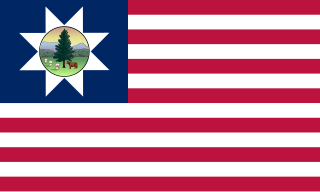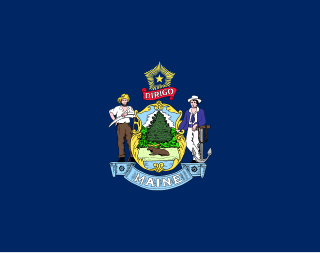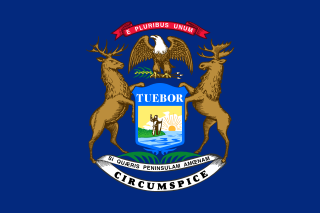
Philip Henry Sheridan was a career United States Army officer and a Union general in the American Civil War. His career was noted for his rapid rise to major general and his close association with General-in-chief Ulysses S. Grant, who transferred Sheridan from command of an infantry division in the Western Theater to lead the Cavalry Corps of the Army of the Potomac in the East. In 1864, he defeated Confederate forces under General Jubal Early in the Shenandoah Valley and his destruction of the economic infrastructure of the Valley, called "The Burning" by residents, was one of the first uses of scorched-earth tactics in the war. In 1865, his cavalry pursued Gen. Robert E. Lee and was instrumental in forcing his surrender at Appomattox Courthouse.
The 14th Indiana Infantry Regiment, called "The Gallant Fourteenth," was an infantry regiment and part of the Union Army's celebrated "Gibraltar Brigade" during the American Civil War. Mustered on June 7, 1861, it was the state's first regiment organized for three years' service. The 14th Indiana served in many major campaigns and battles mostly in the Eastern Theater. During its three years of service, the regiment had a total of 222 casualties.

John Thomas Wilder was an officer in the Union Army during the American Civil War, noted principally for capturing the critical mountain pass of Hoover's Gap during the Tullahoma Campaign in Central Tennessee in June 1863. Wilder had personally ensured that his "Lightning Brigade" of mounted infantry was equipped with the new Spencer repeating rifle. However, Wilder initially had to appeal to his men to pay for these weapons themselves before the government agreed to carry the cost. The victory at Hoover's Gap was attributed largely to Wilder's persistence in procuring the new rifles, which disoriented the enemy.

The 3rd Vermont Infantry Regiment was a three-years infantry regiment in the Union Army during the American Civil War. It served in the eastern theater, predominantly in the VI Corps, Army of the Potomac, from July 1861 to July 1865. It was a member of the Vermont Brigade.

The 2nd Vermont Infantry Regiment was a three years' infantry regiment in the Union Army during the American Civil War. It served in the eastern theater, predominantly in the VI Corps, Army of the Potomac, from June 1861 to July 1865. It was a member of the famous Vermont Brigade.

The 4th Vermont Infantry Regiment was a three year' infantry regiment in the Union Army during the American Civil War. It served in the Eastern Theater, predominantly in the VI Corps, Army of the Potomac, from September 1861 to July 1865. It was a member of the Vermont Brigade.

The 5th Vermont Infantry Regiment was a three years' infantry regiment in the Union Army during the American Civil War. Organized at St. Albans and mustered in September 16, 1861, it served in the Army of the Potomac (AoP). It departed Vermont for Washington, DC, September 23, 1861.

The 6th Vermont Infantry Regiment was a three years' infantry regiment in the Union Army during the American Civil War. Organized at Montpelier and mustered in October 15, it served in the Army of the Potomac (AoP). It departed Vermont for Washington, DC, October 19, 1861. It served in the Eastern Theater, predominantly in the VI Corps, AoP, from October 1861 to June 1865. It was a part of the Vermont Brigade.
The following Union Army units and commanders fought in the Battle of Chancellorsville of the American Civil War. The Confederate order of battle is listed separately. Order of battle compiled from the army organization during the battle, the casualty returns, and the reports.

The 17th Maine Infantry Regiment was an infantry regiment that served in the Union Army during the American Civil War. It was particularly noted for its service during the 1863 Battle of Gettysburg.

The 1st Michigan Sharpshooters Regiment was an infantry regiment that served in the Union Army's Army of the Potomac during the American Civil War.

The 7th New York Infantry Regiment, later reorganized at the 7th Veteran Infantry Regiment, was an infantry regiment that served in the Union Army during the American Civil War. It was composed almost entirely of German immigrants and is also known as the Steuben Guard or the Steuben Regiment. It should not be confused with the 7th New York Militia, an entirely different regiment whose service overlapped with the 7th New York Volunteers.

The 13th Maine Infantry Regiment was an infantry regiment that served in the Union Army during the American Civil War. The regiment spent 1862–1864 in the Department of the Gulf and finished the war with the Army of the Shenandoah. During its service, it survived a hurricane off the Carolinas en route the Gulf of Mexico, manned the forts guarding the Mississippi Delta, invaded Texas at the Rio Grande and along the coast, fought in Banks' ill-fated Red River Campaign in Louisiana, manned Washington, D.C., defenses, and provided rear-area security for the Shenandoah Valley campaign in 1864 south of Harpers Ferry.

The 18th Independent Battery Indiana Light Artillery, also known as Lilly's Hoosier Battery and Lilly's Battery, was a civil war regiment formed in Indiana during the American Civil War. The regiment was formed at the end of 1860 by 22-year-old Eli Lilly, an Indianapolis pharmacist. He had recruitment posters placed around the city and recruited primarily among his friends and classmates. The unit were first issued 6 "Rodman Guns" and was manned by 156 men. The Battery members stated preference to 3" Ordnance Rifles over the 10 pound Parrott Rifle due to its tendency to bursting. The unit mustered in Indianapolis where it was drilled during 1861, excelling at their skill with firing accuracy. Lilly was elected captain of the unit in August 1862 when the unit was deployed to join the Lightning Brigade commanded by Col. John T. Wilder.

The 72nd Indiana Infantry Regiment, also known as 72nd Indiana Mounted Infantry Regiment, was an infantry and mounted infantry regiment that served in the Union Army during the American Civil War. The regiment served as mounted infantry from March 17, 1863, to November 1, 1864, notably as part of the Lightning Brigade. during the Tullahoma and Chickamauga Campaigns.
The 67th Ohio Infantry Regiment was an infantry regiment in the Union Army during the American Civil War.
The 83rd Indiana Infantry Regiment, sometimes called 83rd Indiana Volunteer Infantry Regiment, was an infantry regiment that served in the Union Army during the American Civil War.

The 39th Massachusetts Volunteer Infantry was an infantry regiment that served in the Union Army during the American Civil War.
The 14th United States Colored Infantry Regiment was an infantry regiment that served in the Union Army during the American Civil War. The regiment was composed of African American enlisted men commanded by white officers and was authorized by the Bureau of Colored Troops which was created by the United States War Department on May 22, 1863.

The 15th Independent Battery, Volunteer Light Artillery was an artillery battery that served in the U.S. Army during the American Civil War.










